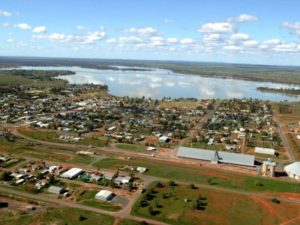Alfred William John Tyack
1903 – 1990
Alfred (Alf) was born in Ballarat on 21 April, 1903, the eldest in a family of ten. He was educated at Katamatite Public School in Victoria.
In 1910 he moved from Numurkah in Victoria to Narromine NSW. In 1917 he moved again by horse and wagon to a property west of Tullibigeal. In a ballot in the early 20’s Alf was successful in drawing a block of land which he cleared, fenced and named “Pine Grove”.
As a young man he was involved in community affairs, playing the cornet in the town band and Australian Rules football in the Local Team. He was the last surviving member of the first Tullibigeal team.
In March 1929 he married Elizabeth Sim in the Tullibigeal Presbyterian Church. They had five children, three sons (Keith Alfred, Leslie George and Raymond William) and two Daughters (Betty Muriel and Isobel Jessie).
A hard working and successful farmer, he had many interests, among them photography. Many district gained pleasure from his slide shows. He was also a keen clay target shooter, winning several district championships in both NSW and Victoria.
In later years his passion was lapidary. He travelled throughout Australia accumulating a large collection of minerals and gemstones. His collection housed in Lake Cargelligo Tourist Information Centre, is a lasting tribute to his talent
He died 2 June 1990 at the age of 87.
The Alf Tyack Rock Collection
- Inlaid polished stone items and ornaments
There are three round table tops, wall mounted and incorporating inland slices of colourful ornamental minerals. The table tops are about one metre diameter and individual inlaid polished slices are mainly rectangular and square, and 10 – 20cm in size
- Faceted (cut) semi- precious gems
The collection contains 8 small (approx. 0.5 to 1cm) topazes from O’Brien’s Creek, Mt Surprise, QLD. Some have an unusual “tear drop” cut. One cut stone is larger than the others, being about 1 to 1.5cm in size and fashioned in the attractive round brilliant cut.
- Fossils
These are also a very minor component of the collection and include and include shells (pelecypods), corals and ammonites. They appear to have no identification or locality information.
- Meteorite fragment
Presumably of the ‘Forest Vale’ stony meteorite (chondrite).
The meteorite fragment is only small and a bit weathered, but does not represent a part of Tullibigeal’s main claim of specific claim. The ‘Forest Vale’ meteorite fell on the 7th August 1942, at Forest Vale, about 12 miles NE of Tullibigeal, N.S.W. About 29kg of meteorite fell, and approx 19kg of this is currently in the Australian Museum collection in Sydney. The meteorite is a stony one, of the type called an ‘olivine-bronzite chondrite’
- Ultra-Violet viewing box and specimens
This enclosed box contains a ultra-violet lamp tube (long wave UV or ‘black light’) and small mineral specimens which fluoresce in different colours: Broken Hill manganoan calcite (pink) Chinese fluorite (blue-violet) and willemite from Franklin, New Jersey U.S.A. (Green).



